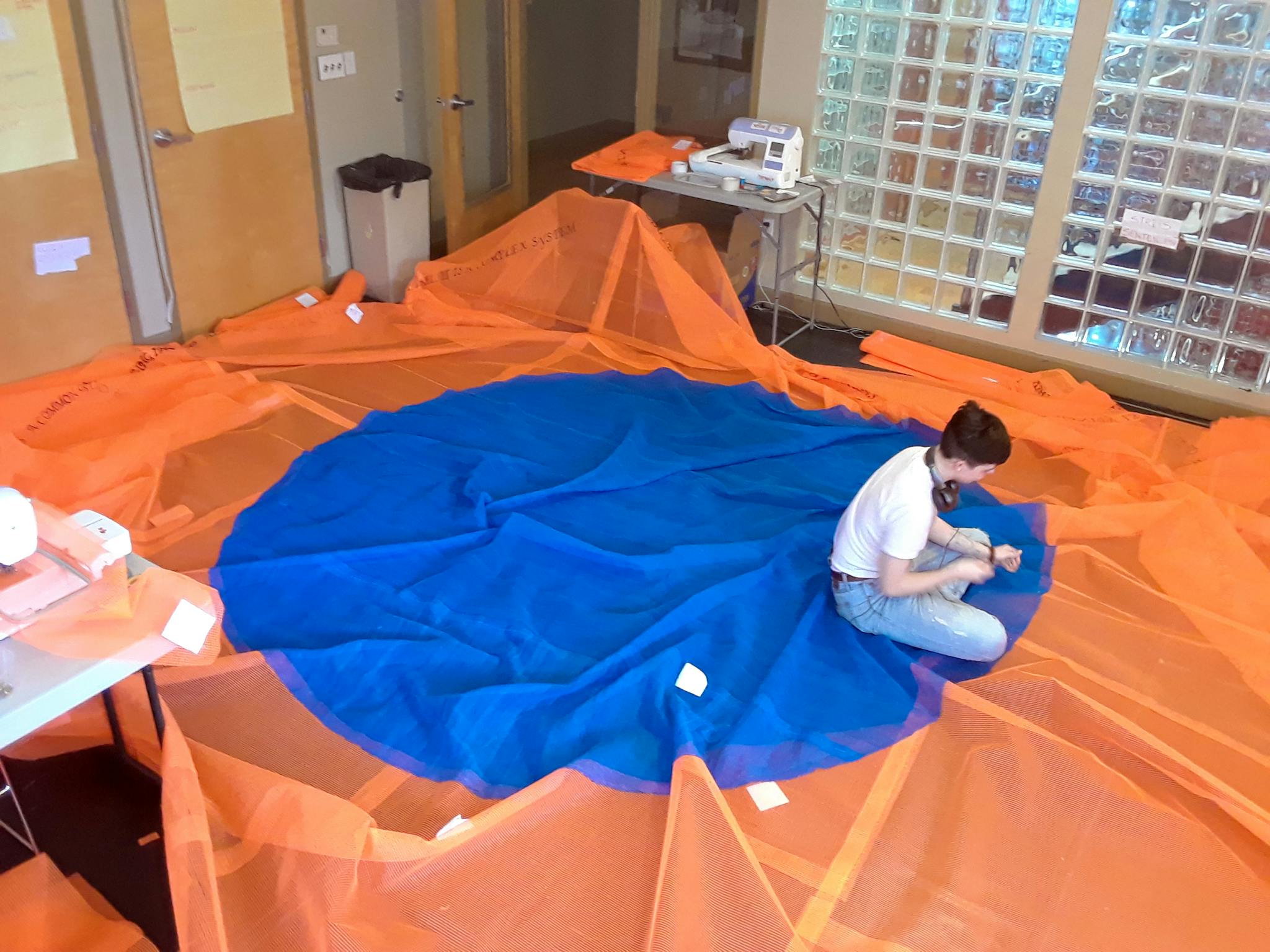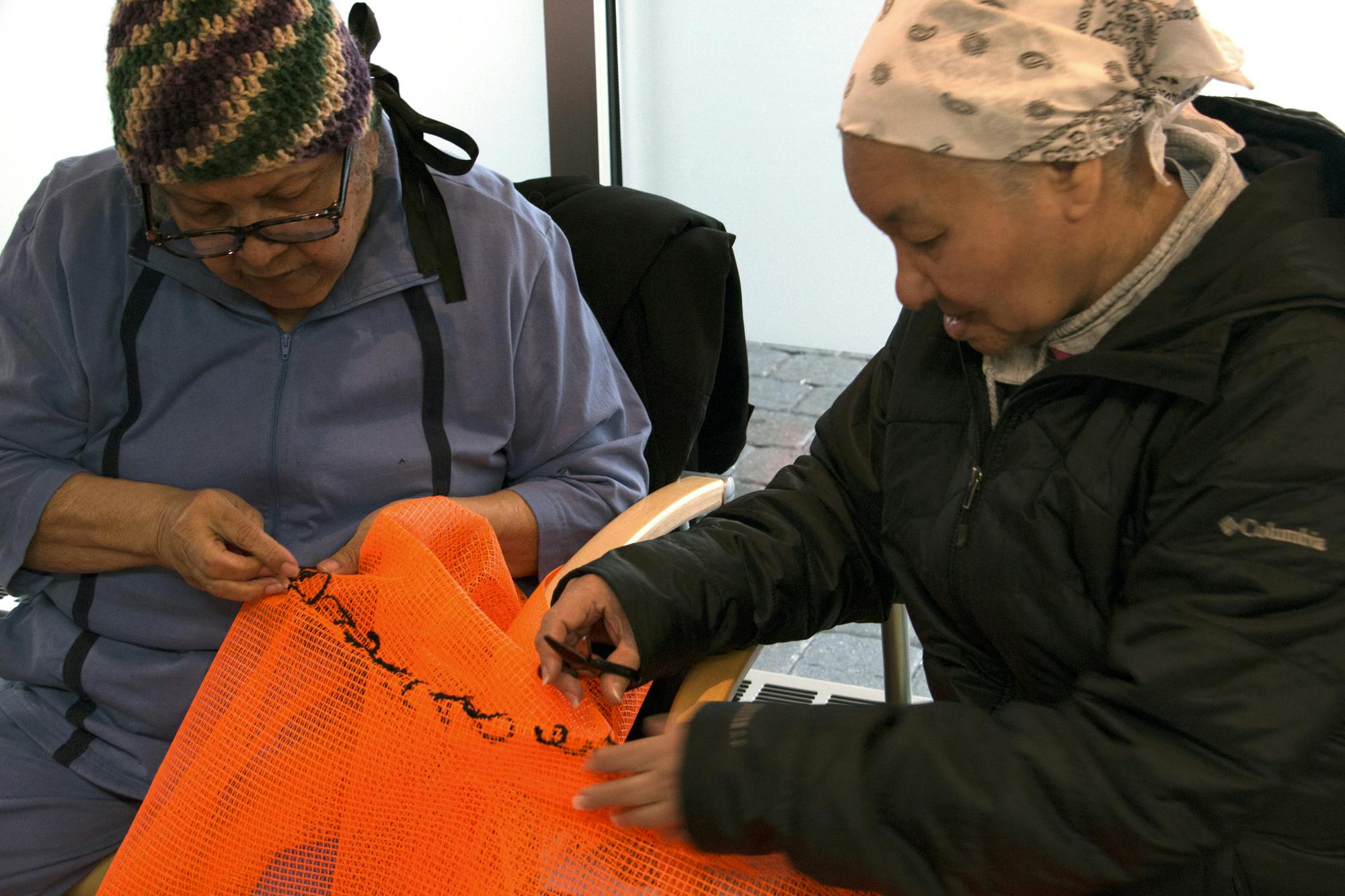A striking public art installation gives the main entrance of Boston’s Prudential Center a makeover as UNLESS, created by Stephanie Cardon, calls attention to the effects of climate change and our individual roles in the issue. Presented by Now + There, an independent curatorial non-profit led by Kate Gilbert, UNLESS is part of eight projects situated around Boston that explore “Art for our Common Home.”
Made with 3,400 square feet of repurposed orange and blue netting debris from construction sites around Boston, UNLESS examines climate change as a social and economic crisis through material production and consumption. The blue circle at the center of the installation stands as a symbol for our planet, which has been affectionately nicknamed “The Blue Marble.” In stark contrast to the abundance of orange netting, its precarious presence urges viewers to consider the impact of the intricate work at such a large scale. Surrounding the blue centerpiece, are hand embroidered excerpts from Pope Francis’s text “Laudato Si’: On Care for Our Common Home” (2015). The minimalist, floor-to-ceiling installation was partially inspired by Amitav Ghosh’s “The Great Derangement: Climate Change and the Unthinkable,” a book that discusses climate change through personal stories, history, and politics. For Cardon, this installation is an opportunity to facilitate dialogue around a global issue that has local impact, as climate change is set to impact coastal cities like Boston with particular severity.
Upon my first interactions with UNLESS, I was struck by the impact of this massive installation in a commercial space. Though, it was evident that there was more to the story than meets the eye. Shortly thereafter, Stephanie Cardon and I met in a quaint coffee shop in Jamaica Plain to further discuss the inspiration behind the piece, the process of bringing her vision to life, and impact this work has made in Boston. The installation will be on view at the Prudential Center through November 2018. Below is an edited transcript of our conversation.
Brandi Griffin: What led you to the creation of UNLESS? Was there a particular moment of inspiration?
Stephanie Cardon: Now + There, the producer [of the piece], took me to the space and when I saw it, I was taken aback because I’ve only ever worked in smaller spaces. I started thinking about how the site could influence the piece. One of the limitations, of course, was that people walking through [the Prudential Center] would not be in a mindset to view art. In order to get attention, it needed to be large and minimal.
BG: To bring those two points together— the large public space to work with and the community aspect of this project, can you elaborate on the collaboration with members of La Villa Victoria and Mass Art Students to make the piece happen?
SC: I knew of La Villa Victoria, a Puerto Rican community here, because of their arts program. It was really cool merging the two groups (MassArt students from Puerto Rico and a Boston Puertorican neighborhood) and creating community. I had a generous budget for the project and since I mostly used repurposed materials, I wanted to think about who needed this opportunity both financially and emotionally. . In the end, most of the work ended up being done by me and students who had come to MassArt after last year’s hurricanes.
BG: After you figured out who to work with, what did the process entail?
SC: It’s a 60×60 foot tapestry that started as repurposed debris netting in 5×5 foot squares. I also wanted to embroider words into the netting. The embroidered words were from Pope Francis’ “Laudato Si’: On Care For Our Common Home.” In the actual making of it, we were all working on 5×5 foot squares and we had to piece them together to make the [final] piece. Some people had serious sewing experience, but some had never held a needle. In the craft of it, I kind of just let it follow the maker.
BG: What materials did you utilize and how are they integrated into the piece?
SC: For me, the material is the message. When you work with debris netting [obtained from construction sites around Boston], you’re immediately bringing the narrative of the building boom and its social and environmental impacts into the piece. I later learned that as developers, [Boston Properties, commissioner of the piece] has a strong sustainability mission. Initially, I was expecting to get more pushback, because consumerism and climate change are unavoidably linked, but I didn’t because as it turns out UNLESS resonates with their goals as a company.
BG: And the colors?
SC: Safety orange and blue are the color of the netting… When you put those 2 colors together, it’s an amazing energy. I wanted the blue to be small enough that it would look overwhelmed by the orange, but still have a presence.
BG: Were you ever nervous that your vision for the piece would get lost with so many people working on individual parts?
SC: I was mostly terrified that it wasn’t going to fit together, and I was terrified that it wouldn’t fit in the space… It was challenging and we were working in a really small space. The room was 20 by 15 feet.
BG: So, you finally get the piece all together. What led you to the name UNLESS?
SC: UNLESS comes from Dr. Seuss’ children’s book “The Lorax”. The Lorax is basically a fuzzy little environmental creature trying to get a big business polluter to stop polluting. He leaves behind a pile of rocks that are engraved with the word UNLESS… Unless someone like you cares very much, nothing is going to change.
BG: As a book that was written in the 1970s, “The Lorax” was definitely ahead of its time, but similar to the main character, you included a call to action in your piece. Do you want to elaborate on that aspect of UNLESS?
SC: I created an SMS interface alongside the installation. I thought people would be curious and want to take action. There are links pertaining to Boston specifically, and how the city or which neighborhoods will be impacted [by climate change]. The text message has indirect things you can do. [You can text UNLESSBOS to 555888 to launch it].
BG: When I think of the center of the modern art world, I immediately think of New York City. What was your reason for choosing Boston instead of a place, like New York, with a huge art market?
SC: I came to Boston, not to settle down, but for grad school. I never intended to stay, but I fell in love, quite literally, with my husband. The Boston art scene is not as dynamic as New York’s, but I wanted to get involved in the community aspect of it. I’ve always been less attracted to the commerce of art and more attracted to the community and their ideas.
BG: How do you hope UNLESS is received?
SC: My hope is to energize people… Anyone who is concerned about climate change. Thinking about these things and organizing is the only way to get people to change, so it’s hard to know if piece like this is just another visual stimulus, or if it’s actually getting people to think. I also want people to consider how environmental justice enters into the conversation: those least responsible for the crisis we are experiencing as a planet are the first impacted.
BG: This is definitely an issue that people should be talking about. Do you have any plans for the work to travel outside Boston to reach a greater audience?
SC: I don’t know yet; I’m open to anything and I feel the urgency of this. I think the piece could become a catalyst for community events… Some people could gather around it or under it or on it to get people talking. I’ve been thinking of hosting a sitting on it, but it would require a very large venue with the scale [the piece] is at. There’s a lot of art work that’s collectable and beautiful, but it’s just stuff. This might be an artwork that has multiple lives and uses, so I have to start thinking about where it might travel.
BG: Of course, the big finale. What does the future hold for Stephanie Cardon?
SC: I’m taking a bit of time to regroup (chuckles). Most of my focus is on what else I can do to help those who are already working on issues of climate justice. I’m working on dialing up my activism.. I do that through teaching and being on the sustainability committee at MassArt. I’m trying to be very intentional about it. I’m not ruling out more public art though.





